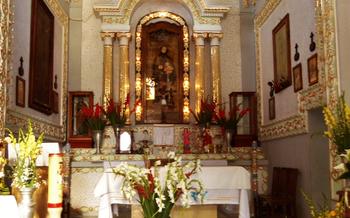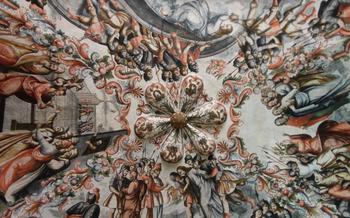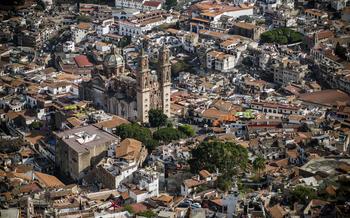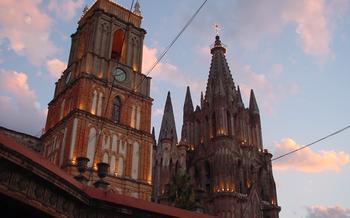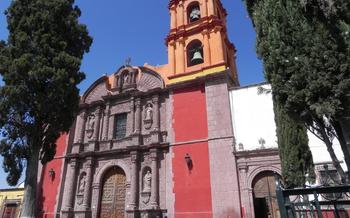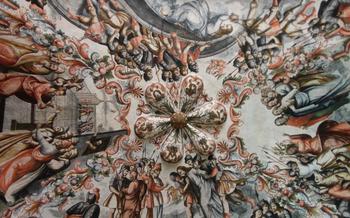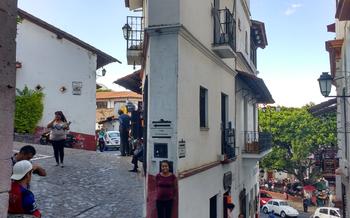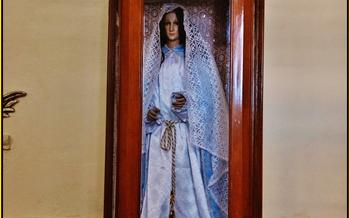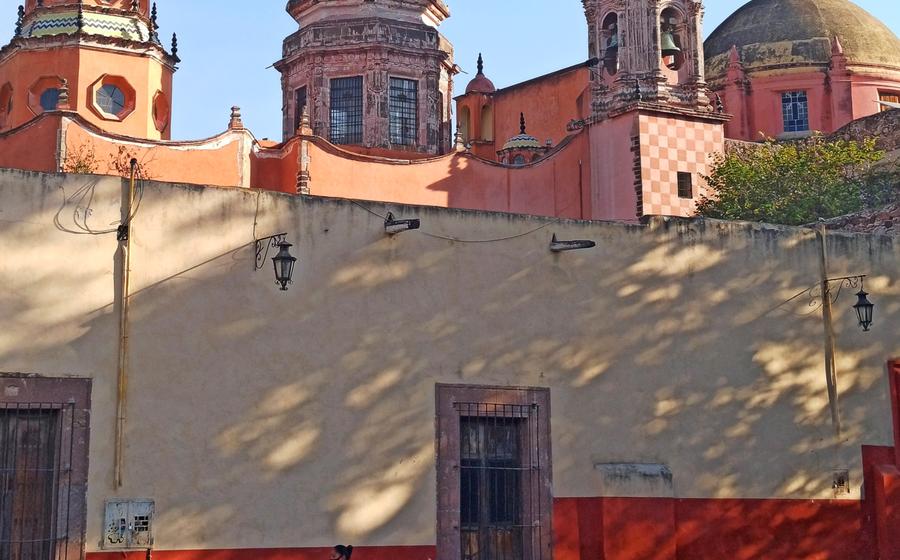
Oratorio de San Felipe Neri
- Time period in which the Oratorio was built
- The Facade of the Oratorio
- The Interior of the Oratorio
- The Altarpiece
- The Dome
- The Chapel of the Virgin of Loreto
- The Sacristy
- The Gardens
- The Music
- The Community
- The Celebrations
- The Restoration
- The UNESCO World Heritage Site
- The Museum
- Insider Tip
Time period in which the Oratorio was built
The Oratorio de San Felipe Neri was built between 1710 and 17It was commissioned by the wealthy mining family, the Condes de la Canal, who played a pivotal role in the development of San Miguel de Allende during the 18th century. The construction of the Oratorio coincided with a period of great economic prosperity in the city, thanks to the flourishing silver mining industry. The Condes de la Canal were deeply religious and wanted to build a grand and opulent church that would reflect their wealth and devotion. They chose the Oratorian order, known for its focus on music and education, to oversee the construction and administration of the Oratorio.
The Facade of the Oratorio
The facade of the Oratorio de San Felipe Neri is a masterpiece of Baroque architecture, showcasing intricate carvings, sculptures, and architectural elements. The main entrance is flanked by two towering columns, topped with ornate capitals and supporting a broken pediment. The tympanum features a relief sculpture depicting the martyrdom of Saint Philip Neri, the patron saint of the Oratorio. The doorway is adorned with cherubs, garlands, and scrollwork, creating a sense of movement and dynamism.
The facade is adorned with a profusion of sculptures, each with its own unique symbolism and meaning. The niches on either side of the entrance house statues of Saint Peter and Saint Paul, the two most prominent apostles of Jesus Christ. Above them, in the second tier, are statues of the four Evangelists – Matthew, Mark, Luke, and John – who wrote the Gospels of the New Testament. The crowning glory of the facade is the figure of Christ the Redeemer, positioned directly above the main entrance, blessing the faithful with outstretched arms.
The facade's architectural elements contribute to its overall grandeur. The use of pilasters, cornices, and moldings creates a sense of rhythm and balance. The play of light and shadow on the facade's many surfaces adds depth and dimension, enhancing the overall visual impact.
In comparison to other Baroque facades in Mexico, the Oratorio de San Felipe Neri stands out for its exceptional craftsmanship and attention to detail. The facade's harmonious composition, intricate carvings, and expressive sculptures make it a true masterpiece of Baroque art and architecture.
The Interior of the Oratorio
The interior of the Oratorio de San Felipe Neri is a masterpiece of Baroque architecture and art. The nave is spacious and well-lit, with side chapels on either side. The walls are covered in intricate Churrigueresque carvings, which depict scenes from the life of Christ, the Virgin Mary, and the saints.
The Churrigueresque style is characterized by its exuberance and movement. The carvings in the Oratorio are full of energy, with twisting columns, overflowing garlands, and cherubs in flight. The overall effect is one of awe and wonder.
The most notable artworks in the Oratorio are the main altarpiece, the dome, and the Chapel of the Virgin of Loreto. The main altarpiece is a towering structure of carved wood and gold leaf. It depicts the Assumption of the Virgin Mary, surrounded by a host of angels and saints. The dome is decorated with illusionistic paintings that depict the heavens, with angels and cherubs floating among the clouds. The Chapel of the Virgin of Loreto is a small, intimate space that houses a beautiful statue of the Virgin Mary. The chapel is decorated with azulejos, or ceramic tiles, which depict scenes from the life of the Virgin.
The Oratorio de San Felipe Neri is a must-see for any visitor to San Miguel de Allende. Its stunning architecture, art, and music make it one of the most important Baroque churches in Mexico.
The Altarpiece
The central altarpiece of the Oratorio de San Felipe Neri is a masterpiece of Churrigueresque art, a style characterized by its exuberant ornamentation and intricate details. The altarpiece is made of wood, covered in gold leaf, and adorned with sculptures, paintings, and other decorative elements.
The central figure of the altarpiece is a sculpture of the Virgin Mary, holding the infant Jesus in her arms. She is surrounded by a host of angels and saints, all of whom are depicted in a dynamic and expressive manner. The altarpiece also features a number of scenes from the life of Christ, including his birth, crucifixion, and resurrection.
The altarpiece is a testament to the skill and craftsmanship of the artists who created it. The use of gold leaf and intricate carving creates a sense of opulence and grandeur. The altarpiece is also a powerful reminder of the importance of religion in the lives of the people of San Miguel de Allende.
In comparison to other Baroque altarpieces, the altarpiece of the Oratorio de San Felipe Neri is notable for its size, complexity, and detail. It is one of the most important examples of Churrigueresque art in Mexico and is considered a masterpiece of Baroque art.
The Dome
The dome of the Oratorio de San Felipe Neri is a masterpiece of Baroque architecture. It is one of the largest domes in Mexico and is considered one of the most beautiful examples of the Churrigueresque style. The dome is constructed of brick and mortar and is supported by a system of arches and pendentives. It is decorated with intricate stucco work and features a series of windows that allow light to flood into the interior.
The dome's most striking feature is its illusionistic painting. The painting was created by Miguel Cabrera, one of the most renowned artists of the Mexican Baroque period. Cabrera used a technique called trompe l'oeil to create the illusion of a three-dimensional space. The painting depicts a celestial scene with clouds, angels, and cherubs. The illusionistic effect is so convincing that it is difficult to tell where the painting ends and the real dome begins.
The dome of the Oratorio de San Felipe Neri is a powerful symbol of the Catholic faith. It represents the heavens and the glory of God. The dome's illusionistic painting invites viewers to contemplate the mysteries of the afterlife and to experience a sense of awe and wonder.
The dome of the Oratorio de San Felipe Neri is a must-see for anyone interested in Baroque architecture. It is a stunning example of the Churrigueresque style and is one of the most beautiful domes in Mexico. The dome's illusionistic painting is a masterpiece of Baroque art and is a testament to the skill and artistry of Miguel Cabrera.
The Chapel of the Virgin of Loreto
Tucked away in a side aisle of the Oratorio, the Chapel of the Virgin of Loreto is a hidden gem that is well worth seeking out. Dedicated to the Virgin Mary, the chapel is believed to have been founded in the late 18th century by a wealthy local family. It is adorned with intricate Churrigueresque carvings and features a beautiful altarpiece depicting the Virgin Mary holding the infant Jesus.
The chapel is a popular destination for pilgrims and visitors alike, who come to pray to the Virgin Mary and to seek her intercession. It is also a popular spot for weddings and other special events.
The Chapel of the Virgin of Loreto is a beautiful example of Mexican Baroque architecture and is a must-see for anyone visiting the Oratorio de San Felipe Neri. It is comparable to other chapels in the Oratorio in its size and decoration, but it is unique in its dedication to the Virgin of Loreto, who is a popular figure in Mexican Catholicism.
The Sacristy
The sacristy of the Oratorio de San Felipe Neri is a small, yet richly decorated room located off the main nave. It served as a private space for the priests and other clergy to prepare for religious services. The walls are lined with intricate wood carvings depicting scenes from the Bible, while the ceiling is adorned with a fresco depicting the Assumption of the Virgin Mary. The furnishings of the sacristy are also noteworthy, including a large wooden table, several chairs, and a beautiful lavabo (sink) made of marble.
The sacristy of the Oratorio is a reminder of the important role that the clergy played in the daily life of the church. It was here that the priests would gather to prepare for Mass, to say their prayers, and to discuss matters of faith. The sacristy also served as a storage space for the church's vestments, vessels, and other sacred objects.
In comparison to other sacristies in Baroque churches, the sacristy of the Oratorio is relatively small and modest in its decoration. This is likely due to the fact that the Oratorio was a relatively poor church, and its resources were limited. However, the sacristy of the Oratorio is still a beautiful and well-preserved example of Baroque architecture and art.
The Gardens
The gardens of the Oratorio de San Felipe Neri are a testament to the Baroque love of nature and symmetry. Laid out in a formal geometric pattern, the gardens feature a variety of colorful flowers, shrubs, and trees. At the center of the gardens is a fountain with a statue of the Virgin Mary. The gardens are a popular spot for visitors to relax and enjoy the beauty of the Oratorio. They are also a popular venue for weddings and other special events.
The gardens are an important part of the Oratorio's overall design. They provide a sense of balance and harmony to the complex. The gardens are also a reminder of the Oratorio's connection to the natural world. They are a place where visitors can come to appreciate the beauty of God's creation.
The gardens of the Oratorio de San Felipe Neri are a unique and beautiful example of Baroque garden design. They are a must-see for any visitor to San Miguel de Allende.
The Music
The Oratorio de San Felipe Neri was renowned for its music. The church employed a choir of skilled singers and instrumentalists who performed polyphonic masses, motets, and hymns during religious services. The music was an integral part of the Baroque experience, enhancing the drama and devotion of the liturgy.
The Oratorio's music was composed by many talented musicians, including Ignacio de Jerusalem, Manuel de Sumaya, and Juan Garcia de Zéspedes. These composers incorporated elements of Spanish, Italian, and indigenous Mexican musical traditions into their works. The result was a rich and diverse soundscape that reflected the cultural heritage of San Miguel de Allende.
The music of the Oratorio not only served a liturgical function but also played an important role in the community's social and cultural life. Concerts and music festivals were held regularly at the church, attracting audiences from all over the region. These events provided opportunities for people to come together, celebrate their faith, and enjoy the beauty of Baroque music.
In comparison to other Baroque musical traditions, the music of the Oratorio de San Felipe Neri was unique in its blend of European and indigenous elements. The use of indigenous instruments, such as the teponaztli and the huehuetl, added a distinctive flavor to the music, setting it apart from the predominantly European musical traditions of the time.
The Community
The Oratorio de San Felipe Neri is deeply intertwined with the community of San Miguel de Allende. For centuries, it has served as a spiritual and cultural hub, bringing people together for worship, celebration, and fellowship. The Oratorio has played a crucial role in shaping the town's identity, contributing to its rich cultural heritage and vibrant community spirit.
The Oratorio is a source of pride for the people of San Miguel de Allende. They take great care in preserving and maintaining this architectural masterpiece, ensuring that it continues to serve as a symbol of their faith and community. The Oratorio is also a popular tourist attraction, drawing visitors from around the world who come to admire its beauty and learn about its history.
Throughout the year, the Oratorio hosts numerous events and celebrations that bring the community together. These events include religious festivals, concerts, art exhibitions, and cultural workshops. The Oratorio is also a popular venue for weddings, baptisms, and other special occasions, reflecting its central role in the lives of the people of San Miguel de Allende.
The community's deep connection to the Oratorio is evident in the many stories and legends that have been passed down through generations. These stories often revolve around miracles and divine interventions attributed to the Oratorio, further strengthening the bond between the people and their beloved church.
The Oratorio de San Felipe Neri is more than just a building; it is a living testament to the enduring faith and cultural heritage of the people of San Miguel de Allende. It is a place where history, art, and community come together to create a unique and unforgettable experience for all who visit.
The Celebrations
The Oratorio de San Felipe Neri is a vibrant hub for religious and cultural celebrations throughout the year. The most important festival is the annual Feast of San Felipe Neri, held on May 26th. During this grand celebration, the Oratorio is adorned with colorful decorations, and a lively procession winds its way through the streets of San Miguel de Allende, carrying the statue of the saint. Music, dance, and feasting fill the air as the community comes together to honor their patron saint.
Other notable celebrations at the Oratorio include Holy Week and Christmas. During Holy Week, the Oratorio hosts solemn processions and services commemorating the Passion of Christ. At Christmas, the Oratorio is transformed into a winter wonderland, with elaborate Nativity scenes and festive decorations. The community gathers for special masses and concerts to celebrate the birth of Jesus.
These celebrations not only showcase the deep faith and devotion of the San Miguel de Allende community but also serve as important cultural events that bring people together. They are a testament to the enduring legacy of Baroque art and architecture, which continues to inspire and captivate visitors from around the world.
The Restoration
The Oratorio has undergone several restoration efforts throughout its history, the most significant of which took place in the 20th century. In the 1950s, the Oratorio was in a state of disrepair, with many of its interior features damaged or lost. A group of local citizens and art historians formed a committee to oversee the restoration, which began in 195
The restoration project was a massive undertaking, involving the repair and conservation of the Oratorio's facade, interior, and dome. The team of restorers used traditional techniques and materials to ensure that the Oratorio's original beauty was preserved. The restoration was completed in 1962, and the Oratorio was reopened to the public.
In the 1980s, the Oratorio underwent another round of restoration, which focused on the gardens and surrounding grounds. The gardens were replanted with native plants, and the walkways and fountains were repaired. The restoration of the gardens was completed in 1987, and the Oratorio was declared a UNESCO World Heritage Site.
The Oratorio's restoration is a testament to the enduring legacy of Baroque architecture in Mexico. Thanks to the efforts of dedicated individuals and organizations, the Oratorio has been preserved for future generations to enjoy.
The UNESCO World Heritage Site
The Oratorio de San Felipe Neri's exceptional cultural and historical significance has earned it the prestigious designation of a UNESCO World Heritage Site. This recognition is bestowed upon landmarks and monuments that are considered to be of outstanding universal value.
To be inscribed on the World Heritage List, a site must meet at least one of ten selection criteria established by UNESCO. The Oratorio satisfies several of these criteria, including:
-
Criterion (i): The Oratorio is a masterpiece of human creative genius, showcasing the extraordinary artistic and technical achievements of the Baroque period.
-
Criterion (ii): The Oratorio exhibits an exceptional interchange of human values over a span of time, representing the fusion of indigenous and European artistic traditions during the colonial era.
-
Criterion (iv): The Oratorio is an outstanding example of a building type that represents a significant stage in human history, serving as a testament to the global reach and influence of Baroque architecture.
By virtue of its exceptional beauty, historical significance, and cultural relevance, the Oratorio de San Felipe Neri stands as a cherished symbol of Mexico's rich heritage and a treasure of global importance.
The Museum
Within the walls of the Oratorio de San Felipe Neri, a treasure trove awaits in the form of a museum dedicated to preserving and showcasing the rich history and cultural significance of this Baroque masterpiece. Step into this sanctuary of knowledge and immerse yourself in an array of fascinating exhibits that bring to life the stories and artistry that shaped the Oratorio.
The museum's collection boasts a diverse range of artifacts, including religious relics, paintings, sculptures, and vestments that offer a glimpse into the spiritual and artistic traditions of the 18th century. Admire the intricate details of gold-leafed altarpieces, marvel at the vibrant colors of colonial-era paintings, and gain insights into the lives of the devout individuals who once graced these hallowed halls.
One of the highlights of the museum is the display of original blueprints and architectural drawings that provide a behind-the-scenes look into the creative process and construction of the Oratorio. Learn about the challenges faced by the architects and artisans who brought this magnificent structure to life, and discover the techniques and materials employed to achieve its enduring splendor.
The museum also offers a unique opportunity to explore the history of San Miguel de Allende, shedding light on the city's transformation from a humble mining town to a vibrant cultural hub. Through interactive exhibits and multimedia presentations, visitors can delve into the city's colonial past, its struggle for independence, and its emergence as a beloved destination for artists, writers, and travelers from around the world.
Whether you're a history buff, an art enthusiast, or simply someone who appreciates the beauty of Baroque architecture, the museum at the Oratorio de San Felipe Neri is a must-visit destination. Prepare to be captivated as you journey through the centuries and discover the stories that lie within the walls of this architectural masterpiece.
Insider Tip
-
For a truly immersive experience, plan your visit to coincide with one of the many festivals or celebrations held at the Oratorio throughout the year. These events offer a chance to witness the Oratorio's vibrant traditions and connect with the local community.
-
Don't miss the opportunity to explore the Oratorio's charming gardens, a tranquil oasis amidst the bustling city. Take a moment to relax and soak in the beauty of the lush greenery, fountains, and sculptures.
-
Be sure to visit the museum located within the Oratorio, which houses a collection of artifacts and exhibits that provide a deeper understanding of the Oratorio's history and significance.
-
For a unique perspective, consider taking a guided tour of the Oratorio. These tours offer insights into the Oratorio's architecture, artwork, and religious significance, and are led by knowledgeable guides who can answer your questions and share fascinating stories.
-
Remember to dress respectfully when visiting the Oratorio, as it is an active place of worship.
